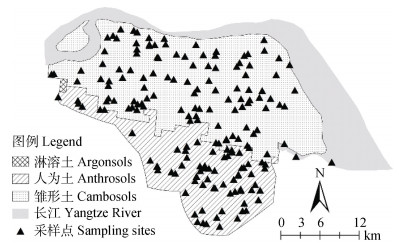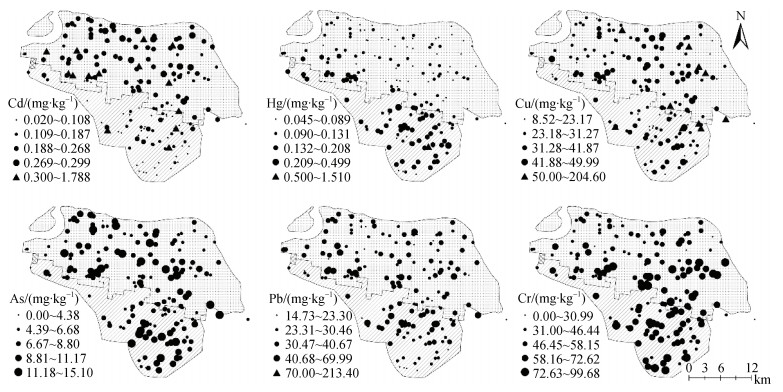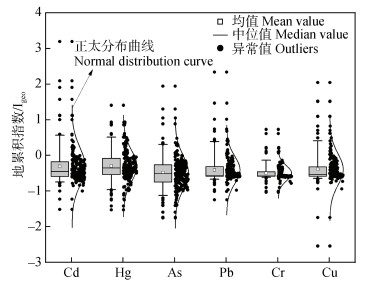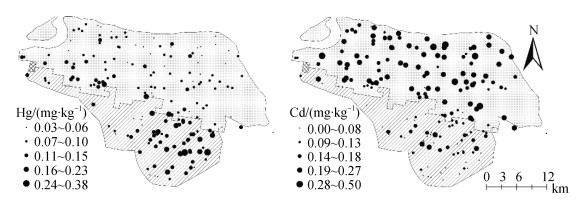2. 中国科学院大学, 北京 100049;
3. 土壤与农业可持续发展国家重点实验室(南京土壤研究所), 南京 210008;
4. 江苏省苏核辐射科技有限责任公司, 南京 210019
2. University of Chinese Academy of Sciences, Beijing 100049, China;
3. State Key Laboratory of Soil & Sustainable Agriculture, Institute of Soil Science, Chinese Academy of Sciences, Nanjing 210008, China;
4. Suhe Radiological Company LTD. (of Jiangsu Province), Nanjing 210019, China
近年来, 随着我国城市化、工业化不断推进, 工业生产中废水、废气的排放以及农业活动中肥料、农药的使用导致土壤中重金属的累积与超标现象日益凸显[1]。土壤重金属污染具有降解难、毒性大、生物累积等特点, 而重金属在土壤中累积不仅会对土壤本身及其周边环境产生不利影响, 也会对农产品安全与人体健康产生威胁[1-2]。针对我国土壤重金属累积与污染问题, 已有学者在土壤重金属污染评价[3-4]、源解析[5-7]、人体健康风险评估[8-9]、污染土壤管控与修复等[10-11]方面开展了大量研究。长江三角洲作为我国经济最发达、城市化进程最快、人口最密集的地区之一, 其土壤重金属污染日趋严重, 农田土壤重金属呈逐年累积趋势[12]。
张家港市作为长江三角洲典型城市, 工业企业类型多样, 农业发达, 其土壤重金属污染的潜在风险较高。Huang等[13]研究了该区内离工厂不同距离处土壤中Hg的累积、迁移和生物有效性, 发现农药投入和工业活动会导致土壤Hg的累积, 而土壤性质的变化则增加了作物对Hg吸收;邵学新[14]在该区通过企业周边采样与大田采样研究, 发现土壤类型差异造成了重金属在空间上分布的差异, 而人为活动会增加重金属在土壤中的累积;刘静等[15]在研究该区不同土地利用方式下土壤重金属的时空分布特征时, 发现农业活动和母质影响了土壤重金属的累积与分布;赵永存等[16]利用序贯指示模拟方法定量评价了该区土壤Cu空间预测过程中的不确定性, 并发现Cu含量高的区域其空间表达的波动性也较高。以上研究表明, 该区土壤重金属空间变异较大, 且含量受人为活动影响明显。本文拟在前人研究基础上, 利用地理探测器定量研究各种因子对农田土壤重金属的影响, 并结合主成分分析法识别土壤重金属污染来源, 为管理部门在解决土壤重金属累积农田的安全利用、源头阻控以及污染农田土壤修复等问题时提供决策支撑。
1 材料与方法 1.1 研究区概况张家港市位于江苏省南部, 地处长江三角洲冲积平原, 是一座港口工业强市。市域总面积999 km2, 其中陆域面积799 km2。气候上属于北亚热带季风气候, 年降水量1 039 mm, 年均温15.2 ℃。研究区土壤类型以北部的雏形土和南部的人为土为主[17](图 1)。雏形土主要由长江冲积母质发育形成, 土壤一般呈碱性, 质地为中、轻壤质;人为土主要由古泻湖相沉积物经长期耕作而成, 土壤呈中性至微酸性, 质地较黏, 为重壤和黏土。

|
图 1 采样点分布与研究区土壤类型 Fig. 1 Spatial distribution of sampling sites and soil types in study area |
样品采集时间为2004-2005年。根据土壤类型、土地利用方式、采样均匀性以及企业排污类型等, 在企业周边大田上共布设188个样点(图 1)。取样时采用GPS记录每个点的经纬度信息并记录样点周围环境特征, 每个采样点周围采集6~8处耕作层土壤(0~20 cm)与亚表层土壤(20~40 cm), 拣去动植物残体、石块, 混匀后缩分至1~2 kg装袋, 送回实验室风干磨碎后待测。
土壤样品经室温风干后磨碎至10目、100目等粒径供分析测试用。pH采用玻璃电极法[18]测定:称取10 g通过10目孔筛的风干土样, 加25 mL去CO2水, 搅拌1 min, 放置30 min后采用PHS-3C型酸度计测定。土壤有机质采用重铬酸钾外加热法测定[18]。
Cd、Pb、Cr和Cu全量的测定采用硝酸-盐酸(v:v, 3:1)消化[19], 具体步骤:称取0.5~1.0 g过100目孔筛的土壤样品放入聚四氟乙烯坩埚中, 加6~12 mL硝酸-盐酸混合液(v:v, 3:1), 摇匀放置过夜;然后将消化坩埚放置烘箱内消化4~5 h, 温度范围为100~170 ℃, 接着在电热板上加热(不需沸腾)至残留约1 mL消化液;冷却至室温后, 用1%硝酸溶解残留物, 过滤至25 mL容量瓶中定容。其中Cd采用石墨炉原子吸收法测定, Pb、Cr和Cu采用火焰原子吸收法测定。Hg经硝酸-硫酸-五氧化二钒消解后采用冷原子吸收测汞仪测定;As采用硫酸-硝酸-高氯酸消解, 二乙基二硫代氨基甲酸银分光光度法测定[20]。
1.3 土壤重金属污染评价方法地累积指数法(Index of Geo-accumulation, Igeo)由德国科学家Muller[21]在1969年提出, 早先用于沉积物中重金属污染评价。由于土壤重金属污染除了受到人类活动、环境地球化学背景值影响之外, 还可能受到自然成岩作用扰动的影响, 而地累积指数法则将这种影响考虑到评价体系中。因此, 地累积指数法现也常用于土壤重金属污染评价。其计算公式如下:
| $ I_{\mathrm{geo}}=\log _{2} \frac{C_{n}}{K \cdot B_{n}} $ | (1) |
式中, Igeo为地累积指数, Cn为样品中重金属浓度, Bn为当地土壤环境背景值(由于重金属在土壤中迁移性较弱, 亚表层土壤受外界影响较小, 本研究选用亚表层土壤重金属含量代替背景值), K为考虑到各地岩石差异会引起背景值变动而选取的系数, 本文K值取1.5[22]。地累积指数的分级与相应的污染程度划分见表 1。
|
|
表 1 地累积指数分级与污染程度 Table 1 Grading of Geo-accumulation index (Igeo) and contamination degree |
地理探测器(GeoDetector)是探测变量空间分异性, 揭示变量间相互关联并反映其背后驱动力的一组统计学分析方法[23]。地理探测器主要用于研究环境因子与人体健康之间的关系[24-25], 但近年来也用于土壤重金属空间变异的驱动因素研究[26-27]。地理探测器模型由因子探测器、交互作用探测器、风险探测器和生态探测器四个子模型组成, 本文主要利用地理探测器的核心模块因子探测器来定量研究不同因子对研究区农田土壤重金属空间分异的影响, 因子探测器q值计算方法详见文献[23]。
1.5 数据来源与分析土壤重金属主要来源于成土母质和人类活动, 而农田土壤重金属污染的来源主要有工业生产过程中“三废”的排放、交通污染、农业面源污染等[26]。考虑到研究区自然地理环境特征、城市发展背景, 本研究选取的因子主要包括以下五类:(1)土壤因子(pH, 有机质, 土壤类型);(2)农业因子(化肥、农药使用量);(3)社会因子(人口密度, GDP);(4)交通因子(与道路距离)和(5)工业因子(工业总产值)。各因子与土壤重金属含量的相关性关系(表 2), 结果表明选取的因子与六种重金属含量具有显著或极显著相关关系。其中土壤有机质数据参考已发表文献[28], 农药、化肥使用量和工业总产值数据来自当地统计年鉴[29], 土壤类型、人口密度和GDP等数据来自中国科学院资源环境科学数据中心, 道路网数据来自OpenStreetMap(www.openstreetmap.org)。
|
|
表 2 土壤重金属含量与各因子之间的相关性 Table 2 Relationships between soil heavy metals and various factors |
为便于数据在地理探测器中的分析, 所有因子在预处理时均统一空间分辨率为1 km×1 km。土壤pH和有机质数据采用逆距离权重法进行插值以获取其在全区的分布;研究区内各镇农药和化肥使用量根据各镇耕地面积占研究区耕地总面积比例与总使用量进行换算;所有因子在正式分析前均进行离散化处理。
2 结果与讨论 2.1 土壤重金属含量特征六种重金属在表层土壤的含量显著高于亚表层, 表层土壤中Hg、Cd、Cu、As、Pb和Cr分别有79.79%、71.28%、64.89%、57.98%、57.45%和45.21%的点位高于亚表层土壤, 且由图 2可见表层土壤重金属的变异性高于亚表层土壤, 表明表层土壤重金属含量受外界活动影响大。表层土壤中Hg和Cd的变异性最大, Cu和Pb的变异性次之, As和Cr则表现出较弱的变异性。

|
图 2 研究区表层(0~20 cm)、亚表层(20~40 cm)土壤重金属含量 Fig. 2 Heavy metal concentrations in the surface (0~20 cm) and subsurface (20~40 cm) soil of the study area |
Cd和Hg的含量在空间上分别呈现出“北高南低”和“南高北低”的分布特征, Cd高浓度点主要集中分布在北部, 而Hg的高浓度点除南部分布比较集中外, 中部也有较高浓度点位分布。土壤中Cu含量在空间上的总体特征为北部高于南部, 但高浓度点主要分布在研究区东南部、中部和西部。As在研究区南部和北部均有高浓度点位分布, 且高浓度点位主要分布在西北、中部和东部区域。Pb的含量在空间上的分布特征并不明显, 其高浓度的点在研究区各部均有分布, 其中在研究区西北部、中部和东部分布较为集中。Cr的高浓度点主要分布在研究区中部、东部和南部(图 3)。

|
图 3 研究区表层土壤重金属含量的空间分布特征 Fig. 3 Spatial distribution characteristics of heavy metal concentrations in the surface soil of the study area |
与《土壤环境质量-农用地土壤污染风险管控标准》(GB 15618-2018)的风险筛选值相比, Cu、Cd和Hg超过风险筛选值的比例依次为2.13%、1.06%和0.53%, As、Cr和Pb无点位超过筛选值。利用地累积指数法对研究区农田土壤重金属污染进行评价(图 4)。Cd和Hg的污染程度较重, Cd有3.21%的样点处于中度污染状态, 8.56%的点位处于轻度-中度污染状态;Hg有20.86%的样点处于轻度-中度污染状态。As、Cu、Pb和Cr各有12.23%、11.17%、9.63%和4.79%的样点处于污染状态。综上, 研究区农田土壤重金属污染的地累积指数评价结果按照由重至轻顺序依次为:Cd > Hg > As > Cu > Pb > Cr。

|
图 4 重金属的地累积指数评价结果 Fig. 4 Assessment of Geo-accumulation index (Igeo) of heavy metals |
以上分析可以看出, 研究区表层土壤中六种重金属含量均显著高于亚表层, 表明这六种元素在表层土壤中存在累积现象, 但累积程度明显不同。Hg和Cd累积程度最高, Cu、As、Pb次之, Cr最弱。地累积指数评价结果与累积趋势较为一致, 其显示Cd和Hg污染状况较其他四种重金属严重, Hg污染点位较Cd多, Cd污染状况较Hg严重;而As、Cu、Pb和Cr污染状况相对较轻, 部分点位处于污染状态, 个别样点处于中度污染和中度-强污染状态。
2.4 土壤重金属影响因子探测因子探测分析表明(表 3), 化肥和农药的使用以及工业总产值对六种重金属空间分异均有较大的解释力, 表明人类活动对研究区土壤重金属含量的影响明显。其他因子对土壤重金属的空间分异也有影响, 如GDP、人口密度及与道路距离对Pb的解释力最大, 说明社会活动和交通活动对土壤中Pb的空间变异影响最大, 李雨等[27]研究湘潭县农田土壤重金属污染的驱动因子时, 也发现GDP影响了重金属Pb的空间分异。此外, 土壤本身性质也会对某些重金属的空间分异有影响, 如pH、土壤有机质和土壤类型对Hg和Cd空间分异的解释力最大。
|
|
表 3 环境因子对六种重金属的解释力q值 Table 3 Explanatory power (q value) of the studied factors for the six soil heavy metals |
主成分分析提取四个主成分的累积方差占总方差的77.63%, 基本上能够解释原始变量, 其中第一主成分的方差贡献率为22.58%, 第二、三和四主成分的方差贡献率分别为20.49%、17.45%和17.10%。同一个主成分下具有较高因子载荷的重金属具有相同的来源。
As和Cr在第一主成分下具有较高的因子载荷, 其分别为0.75和0.85。因子探测结果显示研究区内的农业活动对土壤中As和Cr的空间分异具有较大的影响, 结合该地统计年鉴[29]发现, 研究区在21世纪初具有较高的农药与化肥使用背景, 因此认为研究区土壤中As和Cr主要来源于农业活动中使用的化肥与农药;此外, 因子探测结果还显示工业活动也会影响土壤中As和Cr的空间分异。Matschullat[30]指出冶炼铜、燃煤及使用含砷农药是砷进入环境中的主要途径, Cai等[31]研究表明无机砷化合物如砷酸钙、砷酸钠等物质常用于杀虫剂中以提高杀虫效率;鲍丽然等[32]认为工业生产中煤炭燃烧释放的Cr会以干湿沉降的方式进入土壤, 刘志红等[33]在研究进口化肥中重金属元素的含量时发现复混肥中Cr含量超标, Luo等[34]发现Cr通过化肥使用途径进入农田的比例为20.1%, 这均说明农业活动与工业活动会导致土壤中As与Cr的累积。因此, 第一主成分代表As和Cr的来源为农业源和工业源。
第二主成分与Hg和Cd具有较高的相关性, 因子载荷分别为0.86和-0.68。因子探测结果显示研究区农业活动对土壤中Hg和Cd的空间分异影响较大, 结合前文已提及研究区具有高投入的农药与化肥使用背景, 这说明农业活动会造成土壤中Hg和Cd的累积。由此可见, 在研究区内降低农药和化肥使用量的同时, 结合农业工程措施开展精准施肥与施药技术显得尤为必要。对比采样时期该区内各镇工业总产值[29]与土壤Hg和Cd的空间分布特征(图 3)发现, 工业总产值高的区域其土壤中Hg和Cd的含量亦较高, 由此可见土壤中Hg和Cd的来源还与研究区内的工业活动相关。这与Luo等[34]在研究中发现大气沉降和化学肥料的使用是Hg进入土壤的主要方式, Streets等[35]在对中国汞排放的研究中指出煤燃烧和有色金属冶炼是主要的汞排放途径, Micó等[36]指出农业生产中磷肥的使用会导致Cd在土壤中累积等研究结论相似。因此在工业生产中应当鼓励发展清洁生产技术、提倡工业废物集中处理等措施以降低企业生产对土壤的影响。此外, 研究区土壤中Hg、Cd在表层(图 3)和亚表层(图 5)中的分布均表现出一致性, 说明二者在土壤中的来源还与母质有很大关系。因此, 第二主成分除了受到农业活动和工业活动的影响外, 还受到土壤母质的影响。

|
图 5 土壤亚表层中Hg与Cd含量的空间分布 Fig. 5 Spatial distribution of Hg and Cd concentrations in the subsurface soil |
Cu在第三主成分下载荷最高, 为0.95。从因子探测结果来看, 农业活动和工业活动对土壤中Cu空间分异的影响较大。该地统计年鉴[29]数据显示, 研究区东部乡镇农业投入较大, 而该地土壤中Cu含量亦较其他地区高, 因此认为土壤中Cu的来源与研究区农业活动有关。Luo等[34]对中国农田土壤重金属输入/输出平衡研究中发现农业投入(禽畜粪便[37]、杀虫剂和化肥)和大气沉降中Cu的含量分别占农田土壤Cu总输入量的79.28%和18.30%, 这说明土壤中Cu含量除受农业活动影响外, 工业活动也存在一定的影响, 这与本文因子探测结果一致。此外在采样过程中还发现研究区中部集中分布着一些养殖场, 养殖活动与动物粪肥的使用也是研究区中部土壤Cu累积的原因之一。这均表明第三主成分能够反映农业和工业活动对土壤Cu含量的影响。
第四主成分与土壤Pb相关性较高, 因子载荷为0.98。Ni和Ma[38]在研究中发现大气沉降是Pb进入土壤中的主要方式, 华明等[39]和Chen等[40]在研究中指出交通活动造成了道路两旁土壤中Pb的累积。这说明工业排放与汽车尾气是土壤中Pb的主要来源。本研究通过因子探测器发现工业活动、社会活动以及交通活动对土壤中Pb的空间变异解释力较大, 这与文献研究结论类似。Ni和Ma [38]指出近年来农业生产中使用的氮肥中Pb的含量有增加的趋势, 说明化肥的使用也会导致土壤中Pb的累积, 本研究的因子探测结果也显示该区农业活动影响土壤Pb的空间分异。因此, 第四主成分主要受到了研究区农业活动、工业活动、交通活动以及社会活动的共同影响。
3 结论研究区农田表层土壤重金属呈现出不同程度的累积趋势, 表层土壤中Hg、Cd、Cu、As、Pb和Cr各有79.79%、71.28%、64.89%、57.98%、57.45%和45.21%的点位高于底层土壤, 其累积程度按由重到轻的顺序为:Hg > Cd > Cu > As > Pb > Cr。表层土壤中Cu、Cd和Hg超过《土壤环境质量-农用地土壤污染风险管控标准》(GB 15618-2018)中风险筛选值的比例依次为2.13%、1.06%和0.53%, As、Cr和Pb无点位超过筛选值。地累积指数污染评价结果表明Cd与Hg污染较其他四种重金属严重, Cd和Hg各有12.83%和21.28%的样点处于污染状态, 而As、Cu、Pb和Cr各有12.23%、11.17%、9.63%和4.79%的样点处于污染状态。因子探测分析显示, 农药和化肥的使用量以及工业总产值对六种土壤重金属的空间分异有更好的解释力, 其他因子能解释某些特定重金属的空间分异。土壤来源分析表明, 土壤中As和Cr的来源为农业源和工业源;Cd和Hg的来源除了受农业活动和工业活动影响外, 土壤母质对二者含量的影响也较明显;研究区内畜禽养殖、农业和工业生产活动等导致土壤中Cu的累积;土壤中Pb的来源与变异则受到研究区内农业活动、工业活动、交通活动和社会活动的共同影响。总之, 研究区土壤重金属总体上存在累积趋势, 但程度不同, 人类活动(农业活动和工业活动)是导致研究区内土壤重金属累积的主要因素, 研究区内的交通和社会因素等对土壤中特定重金属累积的影响则需更进一步地探讨与研究。
| [1] |
Zeng X B, Xu J M, Huang Q Y, et al. Some deliberations on the issues of heavy metals in farmlands of China (In Chinese)[J]. Acta Pedologica Sinica, 2013, 50(1): 186-194. [曾希柏, 徐建明, 黄巧云, 等. 中国农田重金属问题的若干思考[J]. 土壤学报, 2013, 50(1): 186-194.]
(  0) 0) |
| [2] |
Hough R L, Breward N, Young S D, et al. Assessing potential risk of heavy metal exposure from consumption of home-produced vegetables by urban populations[J]. Environmental Health Perspectives, 2004, 112(2): 215-221. DOI:10.1289/ehp.5589
(  0) 0) |
| [3] |
Ma C L, Zhou J M, Wang H Y, et al. Methods for assessment of heavy metal pollution in cropland soils-A case study of Changshu (In Chinese)[J]. Journal of Ecology and Rural Environment, 2006, 22(1): 48-53. [马成玲, 周健民, 王火焰, 等. 农田土壤重金属污染评价方法研究——以长江三角洲典型县级市常熟市为例[J]. 生态与农村环境学报, 2006, 22(1): 48-53.]
(  0) 0) |
| [4] |
Zhao H A, Zang L, Zhang G J, et al. Soil heavy metal pollution characteristics and source apportionment at county scale-Take Zhaoxian County as an example (In Chinese)[J]. Chinese Journal of Soil Science, 2018, 49(3): 710-719. [赵红安, 臧亮, 张贵军, 等. 县域尺度土壤重金属污染特征及源解析——以赵县为例[J]. 土壤通报, 2018, 49(3): 710-719.]
(  0) 0) |
| [5] |
Hu W Y, Wang H F, Dong L R, et al. Source identification of heavy metals in peri-urban agricultural soils of southeast China:An integrated approach[J]. Environmental Pollution, 2018, 237: 650-661. DOI:10.1016/j.envpol.2018.02.070
(  0) 0) |
| [6] |
Dong B, Zhang R Z, Gan Y D, et al. Multiple methods for the identification of heavy metal sources in cropland soils from a resource-based region[J]. Science of the Total Environment, 2019, 651: 3127-3138. DOI:10.1016/j.scitotenv.2018.10.130
(  0) 0) |
| [7] |
Li F, Liu S Y, Li Y, et al. Spatiotemporal variability and source apportionment of soil heavy metals in a industrially developed city (In Chinese)[J]. Environmental Science, 2019, 40(2): 934-944. [李锋, 刘思源, 李艳, 等. 工业发达城市土壤重金属时空变异与源解析[J]. 环境科学, 2019, 40(2): 934-944.]
(  0) 0) |
| [8] |
Hu W Y, Huang B, He Y, et al. Assessment of potential health risk of heavy metals in soils from a rapidly developing region of China[J]. Human and Ecological Risk Assessment, 2016, 22(1): 211-225. DOI:10.1080/10807039.2015.1057102
(  0) 0) |
| [9] |
Li N, Kang Y, Pan W J, et al. Concentration and transportation of heavy metals in vegetables and risk assessment of human exposure to bioaccessible heavy metals in soil near a waste-incinerator site, South China[J]. Science of theTotal Environment, 2015, 521: 144-151.
(  0) 0) |
| [10] |
Chen W P, Yang Y, Xie T, et al. Challenges and countermeasures for heavy metal pollution control in farmlands of China (In Chinese)[J]. Acta Pedologica Sinica, 2018, 55(2): 261-272. [陈卫平, 杨阳, 谢天, 等. 中国农田土壤重金属污染防治挑战与对策[J]. 土壤学报, 2018, 55(2): 261-272.]
(  0) 0) |
| [11] |
Li Y Z, Dong J, Liu S Y, et al. Prospect and research of soil pollution control based on risk management (In Chinese)[J]. Ecology and Environmental Sciences, 2017, 26(6): 1075-1084. [李云祯, 董荐, 刘姝媛, 等. 基于风险管控思路的土壤污染防治研究与展望[J]. 生态环境学报, 2017, 26(6): 1075-1084.]
(  0) 0) |
| [12] |
Hang X S, Wang H Y, Zhou J M. Prevention and regulation countermeasures of soil heavy metal contamination in Yangtze River Delta (In Chinese)[J]. Chinese Journal of Soil Science, 2013, 44(1): 245-251. [杭小帅, 王火焰, 周健民. 长江三角洲地区土壤重金属污染的防治与调控[J]. 土壤通报, 2013, 44(1): 245-251.]
(  0) 0) |
| [13] |
Huang B, Wang M, Yan L X, et al. Accumulation, transfer, and environmental risk of soil mercury in a rapidly industrializing region of the Yangtze River Delta, China[J]. Journal of Soils Sediments, 2011, 11: 607-618. DOI:10.1007/s11368-011-0341-8
(  0) 0) |
| [14] |
邵学新.经济高速发展地区人为作用对土壤重金属污染的影响及其生态效应研究[D].南京: 中国科学院南京土壤研究所, 2006. Shao X X. Impacts of human activities on soil heavy metal distribution and their ecological response in a rapid developing region of China[D]. Nanjing: Instiute of Soil Science, Chinese Academy of Sciences, 2006. (  0) 0) |
| [15] |
Liu J, Huang B, Sun W X, et al. Spatial-temporal distribution and prediction of heavy metals under different soil use patterns in an economically developed area (In Chinese)[J]. Soils, 2011, 43(2): 210-215. [刘静, 黄标, 孙维侠, 等. 经济发达区不同土壤利用方式下重金属的时空分布及预测[J]. 土壤, 2011, 43(2): 210-215.]
(  0) 0) |
| [16] |
Zhao Y C, Huang B, Sun W X, et al. Uncertainty assessment of the spatial patterns of copper contents in topsoil in Zhangjiagang City, China (In Chinese)[J]. Acta Pedologica Sinica, 2007, 44(6): 974-981. [赵永存, 黄标, 孙维侠, 等. 张家港土壤表层铜含量空间预测的不确定性评价研究[J]. 土壤学报, 2007, 44(6): 974-981.]
(  0) 0) |
| [17] |
沙洲县土壤普查办公室, 苏州农业局.江苏省沙洲县土壤志[M].江苏张家港市: 江苏省沙洲县土壤普查办公室, 1984. Office of Soil Survey in Shazhou County, Agriculture Bureau of Suzhou City, Office of Survey in Jiangsu Province.The soils of Shazhou County[M]. 1984. (  0) 0) |
| [18] |
Lu R K. Analytical methods for soil and agro-chemistry (In Chinese). Beijing: China Agricultural Science and Technology Press, 2000. [鲁如坤. 土壤农业化学分析方法[M]. 北京: 中国农业科技出版社, 2000.]
(  0) 0) |
| [19] |
Burt R, Wilson M A, Mays M D, et al. Major and trace elements of selected pedons in the USA[J]. Journal of Environmental Quality, 2003, 32(6): 2109-2121. DOI:10.2134/jeq2003.2109
(  0) 0) |
| [20] |
China National Environmental Montioring Center. Ed. Recent analytical methodsof soil elements (In Chinese). Beijing: China Environment Science Press, 1992. [中国环境监测总站. 土壤元素的近代分析方法[M]. 北京: 中国环境科学出版社, 1992.]
(  0) 0) |
| [21] |
Muller G. Index of geoaccumulation in sediments of the Rhine River[J]. Geochemical Journal, 1969, 2(3): 108-118.
(  0) 0) |
| [22] |
Guo X X, Liu C Q, Zhu Z Z, et al. Evaluation methods for soil heavy metals contamination:A review (In Chinese)[J]. Chinese Journal of Ecology, 2011, 30(5): 889-896. [郭笑笑, 刘丛强, 朱兆洲, 等. 土壤重金属污染评价方法[J]. 生态学杂志, 2011, 30(5): 889-896.]
(  0) 0) |
| [23] |
Wang J F, Xu C D. Geodetector:Principle and prospective (In Chinese)[J]. Acta Geographica Sinica, 2017, 72(1): 116-134. [王劲峰, 徐成东. 地理探测器:原理与展望[J]. 地理学报, 2017, 72(1): 116-134.]
(  0) 0) |
| [24] |
Wang J F, Li X H, Christakos G, et al. Geographical detectors-based health risk assessment and its application in the neural tube defects study of the Heshun region, China[J]. International Journal of Geographical Information Science, 2010, 24(1): 107-127.
(  0) 0) |
| [25] |
Wang H F, Wu Q M, Hu W Y, et al. Using multi-medium factors analysis to assess heavy metal health risks along the Yangtze River in Nanjing, Southeast China[J]. Environmental Pollution, 2018, 243: 1047-1056. DOI:10.1016/j.envpol.2018.09.036
(  0) 0) |
| [26] |
Xiao W, Sui T, Wang X, et al. Assessment and geographical detection of heavy metal pollution in typical farmland soil in Chaohu lake basin (In Chinese)[J]. Transactions of the Chinese Society for Agricultural Machinery, 2018, 49(7): 144-152. [肖武, 隋涛, 王鑫, 等. 巢湖流域典型农田土壤重金属污染评价与地理探测分析[J]. 农业机械学报, 2018, 49(7): 144-152.]
(  0) 0) |
| [27] |
Li Y, Han P, Ren D, et al. Influence factor analysis of farmland soil heavy metal based on the geographical detector (In Chinese)[J]. Scientia Agricultura Sinica, 2017, 50(21): 4138-4148. [李雨, 韩平, 任东, 等. 基于地理探测器的农田土壤重金属影响因子分析[J]. 中国农业科学, 2017, 50(21): 4138-4148.]
(  0) 0) |
| [28] |
Gu Z Q, Shao X X, Qian W F, et al. Quantitative evaluation of soil productivity of farmland in Zhangjiagang City, Jiangsu Province and its significance (In Chinese)[J]. Acta Pedologica Sinica, 2007, 44(2): 354-359. [顾志权, 邵学新, 钱卫飞, 等. 江苏省张家港市耕地地力定量化评价及其意义[J]. 土壤学报, 2007, 44(2): 354-359.]
(  0) 0) |
| [29] |
Suzhou Statistics Bureau. Suzhou statistical yearbook (2002-2006) (In Chinese). Beijing: China Statistic Press, 2002-2006. [苏州统计局. 苏州统计年鉴(2002-2006)[M]. 北京: 中国统计出版社, 2002-2006.]
(  0) 0) |
| [30] |
Matschullat J. Arsenic in the geosphere-A reivew[J]. Science of the Total Environment, 2000, 249(1/): 297-312.
(  0) 0) |
| [31] |
Cai L M, Xu Z C, Bao P, et al. Multivariate and geostatistical analyses of the spatial distribution and source of arsenic and heavy metals in the agricultural soils in Shunde, Southeast China[J]. Journal of Geochemical Exploration, 2015, 148: 189-195. DOI:10.1016/j.gexplo.2014.09.010
(  0) 0) |
| [32] |
Bao L R, Yang L C, Dong J X, et al. Atmospheric deposition characteristic and its influence on the earth surface in western Chongqing agricultural area (In Chinese)[J]. Environmental Pollution & Control, 2016, 38(1): 41-46. [鲍丽然, 杨乐超, 董金秀, 等. 重庆西部农业区大气沉降特征及其对地表的影响[J]. 环境污染与防治, 2016, 38(1): 41-46.]
(  0) 0) |
| [33] |
Liu Z H, Liu L, Li Y. Investigation on the toxic element As, Cd, Pb, and Cr in imported fertilizers (In Chinese)[J]. Phosphate & Compound Fertilizer, 2007, 22(2): 77-78. [刘志红, 刘丽, 李英. 进口化肥中有害元素砷、镉、铅、铬的普查分析[J]. 磷肥与复肥, 2007, 22(2): 77-78.]
(  0) 0) |
| [34] |
Luo L, Ma Y B, Zhang S Z, et al. An inventory of trace element inputs to agricultural soils in China[J]. Journal of Environmental Management, 2009, 90(8): 2524-2530. DOI:10.1016/j.jenvman.2009.01.011
(  0) 0) |
| [35] |
Streets D G, Hao J M, Wu Y, et al. Anthropogenic mercury emissions in China[J]. Atmospheric Environment, 2005, 39(40): 7789-7806. DOI:10.1016/j.atmosenv.2005.08.029
(  0) 0) |
| [36] |
Micó C, Recatalá L, Peris M, et al. Assessing heavy metal sources in agricultural soils of an European Mediterranean area by multivariate analysis[J]. Chemosphere, 2006, 65(5): 863-872. DOI:10.1016/j.chemosphere.2006.03.016
(  0) 0) |
| [37] |
Zhang S Q, Zhang F D, Liu X M, et al. Determination and analysis on main harmful composition in excrement of scale livestock and poultry feedlots (In Chinese)[J]. Plant Nutrition and Fertilizer Science, 2005, 11(6): 822-829. [张树清, 张夫道, 刘秀梅, 等. 规模化养殖畜禽粪主要有害成分测定分析研究[J]. 植物营养与肥料学报, 2005, 11(6): 822-829.]
(  0) 0) |
| [38] |
Ni R X, Ma Y B. Current inventory and changes of the input/output balance of trace elements in farmland across China[J]. PLoS One, Plos One, 2018, 13(6): e0199460. DOI:10.1371/journal.pone.0199460
(  0) 0) |
| [39] |
Hua M, Zhu B W, Liao Q L, et al. Preliminary research on pollution level of heavy metals in farmland soils along both sides of main roads in Jiangsu (In Chinese)[J]. Journal of Geology, 2008, 32(3): 165-171. [华明, 朱佰万, 廖启林, 等. 江苏主要公路两侧农田土壤重金属污染现状初步研究[J]. 地质学刊, 2008, 32(3): 165-171.]
(  0) 0) |
| [40] |
Chen T, Chang Q R, Liu J, et al. Identification of soil heavy metal sources and improvement in spatial mapping based on soil spectral information:A case study in northwest China[J]. Science of the Total Environment, 2016, 565: 155-164. DOI:10.1016/j.scitotenv.2016.04.163
(  0) 0) |
 2021, Vol. 58
2021, Vol. 58


